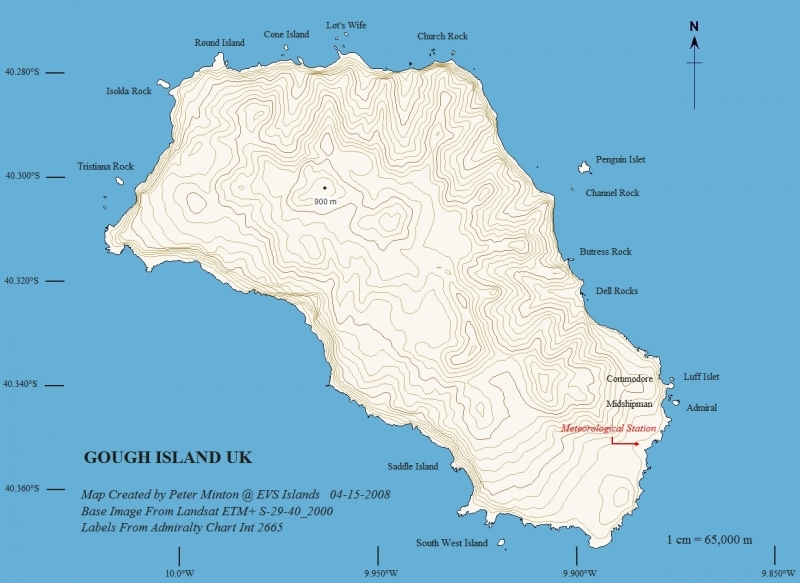Gough Island Wildlife Reserve, United Kingdom
| Topics: |
Contents
- 1 Geographical Location
- 2 Date and History of Establishment
- 3 Area
- 4 Land Tenure
- 5 Altitude
- 6 Physical Features
- 7 Climate
- 8 Vegetation
- 9 Fauna
- 10 Cultural Heritage
- 11 Local Human Population
- 12 Visitors and Visitor Facilities
- 13 Scientific Research and Facilities
- 14 Conservation Value
- 15 Conservation Management
- 16 IUCN Management Category
- 17 Further Reading
Geographical Location
Gough Island (37°18'S - 40°19'29"S) is a World Heritage Site which lies in the South Atlantic Ocean about 350 kilometers (km) south-southeast of Tristan da Cunha and Inaccessible Island at 40°19'29"S x 9°55'43"W. Inaccessible Island is located 45 km south-west of Tristan da Cunha and 350 km north-northwest of Gough Island at 37°18'S x 12°41' W.
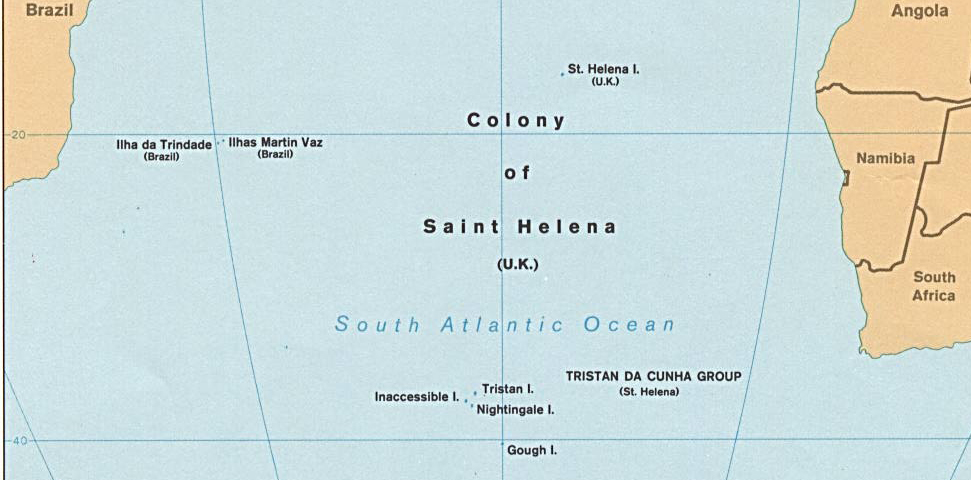 Location of Gough Island (bottom center of map) in the South Atlantic Ocean. Source. CIA
Location of Gough Island (bottom center of map) in the South Atlantic Ocean. Source. CIA
Date and History of Establishment
- 1938: Gough Island proclaimed a British possession in 1938 as part of the Overseas Territory of Tristan da Cunha, part of the Crown Colony of St Helena;
- 1950: Land birds on Gough Island protected under the Tristan da Cunha WIldlife Protection Ordinance;
- 1976: Gough Island, its islets and territorial waters to 3 nautical miles (nm), in 1977 extended to 12nm (22 km), designated a Wildlife Reserve under the Tristan da Cunha Conservation Ordinance;
- 1983: Waters within 200 nm (370 km) of the island are protected by the Fishery Limits Ordinance;
- 1997: Inaccessible Island and its territorial water out to 12 nm was designated a Nature Reserve under the same Conservation Ordinance;
- 2001: The 200 nm protected zone around the Tristan da Cunha and Gough Island group declared a whale sanctuary;
Area
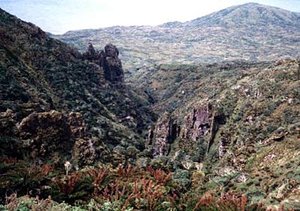 Gough Island, UK (Source: North Dakota State University)
Gough Island, UK (Source: North Dakota State University) The site extends over a total area of 397,900 hectares (ha), comprising: Gough Island: 6,500 ha; marine buffer: 230,000 ha (12 km extension) Inaccessible Island: 1,400 ha; marine buffer: 160,000 ha (12 km extension).
Land Tenure
Crown estate. Both islands are administered by the Island Council of Tristan da Cunha. A meteorological station in the southeast of Gough Island is leased to the South African government.
Altitude
Seabed to 910 meters (m) (Gough Island.); to ± 600 m (Inaccessible Island).
Physical Features
The Tristan da Cunha Islands and Gough Island are part of a chain of South Atlantic volcanic sea-mounts on the east slope of the mid-Atlantic ridge. Gough is the mountainous island summit of a Tertiary volcanic mass separated from the formations of the Tristan group. The island is mountainous, with dramatically steep cliffs forming much of the coastline and an undulating plateau rising up 910 m above sea level. The eastern side of the island is dissected by a series of deep, steep-sided valleys known as glens, which are separated by narrow, serrated ridges. The western side of the island consists of rounded slopes, extending from the central plateau to western sea cliffs. The southern area of the island is the only land below 200 m in height. Boulder beaches are found beneath the cliffs, and there are numerous offshore islets, stacks rocks- most within 100 m of the main island, and none at a distance greater than 1 km. The largest stacks support vascular plants and breeding birds.
Inaccessible Island is a 2-3 million year old remnant of a far larger much eroded volcano, material from which has built up a wide submarine plateau. It was a shield volcano of thin basaltic flows interleaved with ash and scoria overlaid in places by later volcanic domes, plugs and dykes. The island is a 5.7 by 4.6 km undulating plateau rising from 200 m in the east to 500 m in the west above a line of steep cliffs punctuated by waterfalls. The soil is undeveloped and coarse, mostly covered by a thick layer of peat and, in the wet climate, often slumps downslope.
Climate
The islands have a cool-temperate oceanic climate, and lie on the edge of the roaring forties, a seasonally oscillating belt of strong westerly winds south of 40°S. Mean temperatures at sea level are 11.3°C (Gough) and 14.5°C (Tristan) with little seasonal variation. Extreme temperatures at sea level vary from -3°C to 25°C (Gough) and 3°C to 24°C (Tristan). The mean daily temperature variation is 4-5°C, with a mean relative humidity of 80%. Snow may fall on the peaks of Gough between May and January, but rarely occurs at sea level. In association with cyclonic depressions, frontal precipitation falls throughout the year. Mean annual precipitation near sea level is 3,116 millimeters (mm) (Gough) and 1,671 mm (Tristan) with more falling in winter. The cloud base is typically between 300-500 m, although it occasionally descends to sea level. The mean wind speed is 12 meters per second (m/s-1) (Tristan 10 m/s-1), with stronger winds in winter. Gales blow on 5% of summer days and on 15% (Gough) and 10% (Tristan) of winter days. Wind speed increases with altitude, and is exceptionally strong on exposed ridges.
The temperature of the seas surrounding Inaccessible Island increases by some 4°C in summer, influenced by the movement of the Subtropical Convergence from north to south of the island. It is more often on the south so the waters are usually subtropical and the heated summer layer which is confined by a thermocline at 50 m promotes the growth of phytoplankton.
Vegetation
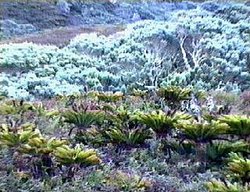 Gough Island, UK (Source: North Dakota State University)
Gough Island, UK (Source: North Dakota State University) The flora of both islands is typical of southern cold-temperate oceanic islands with relatively low species diversity, and a large preponderance of ferns and cryptogams. On Gough Island there are 36 flowering species of which 21 are endemic to the Tristan-Gough Island group and four are restricted to Gough. 27 species of fern are known from the island of which 15 are endemic to the Tristan–Gough group. A large number of bryophytes and lichens are known but not described in detail. Only four alien species are widespread on the island, but the integrity of the ecosystem has recently been threatened by the invasion of an alien groundcover, procumbent pearlwort Sagina procumbens. This very quickly forms dense mats on disturbed ground such as birds’ burrows, peat slips and around the settlement and competes strongly with existing vegetation.
The vegetation on Gough Island varies markedly with changes with altitude and microclimate. Two-meter high tussock grassland, dominated by Spartina arundinacea and tussac grass Parodiochloa flabellata is restricted to areas where salt spray is regular, and it is found on offshore stacks, sea cliffs and adjacent slopes. It extends 300 m up seaward facing slopes on the exposed western side of the island, and to approximately 100 m on the more sheltered eastern side. Extending from tussock grassland to approximately 500 m is a dense vegetation of fernbush. This is dominated by bat’s wing fern Histiopteris incisa, characterised by the hard or Gough tree fern Blechnum palmiforme, and is more extensive on the eastern side of the island and in southern downland areas. This vegetation type is approximately one meter high, occasionally interrupted by the shrubby island tree Phylica arborea. From the upper limits of fernbush communities, wet heath is the dominant vegetation type to 800 m. This is a diverse community of ferns, sedges, grasses, angiosperms and mosses and is dominated by B. palmiforme, crowberry Empetrum rumbrum, grasses and sedges. Above 600 m, peat bogs are widespread. These sodden bogs are 5 m deep in valleys and are dominated by Sphagnum mosses. Fuegian arrowgrass Tetroncium magellanicium and mossy deergrass Scirpus spp. are the only abundant vascular plants found in bogs, although bog margins show a wider diversity, including various grasses. From 600 m, feldmark and montane rock communities are found. These consist of cushion-forming or crevice plants, found on exposed areas such as ridges.
The marine area around Gough Island can be split into two distinct algal zones. From sea level to 5m depth, algae consists mainly of bull kelp Durvillea antarctica, and beyond 20 m is dominated by Laminaria pallida and giant kelp Macrocystis pyrifera. Forty species of algae are recorded, of which two species are endemic to Gough.
On Inaccessible Island there are 213 native species of plants, eight being known only from the island. 60 of the 136 species and 35 of the 46 vascular plants restricted to the Tristan group are also found there, including all ten endemic species. One of these is the pepper tree, an endemic subspecies Peperomia berteroana tristanensis, found in one locality only. Endemism is highest in grasses, ferns and mosses. As with Gough the vegetation is graded by height and exposure. Dense high tussock grass dominates all the coastal lowlands and cliffs up to 200-500 m except in marshes where the pennywort Hydrocotyle capitata is common and on the drier western slopes which are dominated by tree fern Blechnum penna-marina heath. Scattered within the grassland are occasional Phylica arborea trees. Landslips are colonised by both introduced and native species such as southern wild celery Apium australe. Most of the plateau is covered by fernbush. The lower eastern half is dominated by Phylica arborea in a low 3-5 m canopy supporting a dense growth of lichens and mosses where damp. The understorey where open is dense with ferns. The higher western half is dominated by bogfern Blechnum palmiforme between 0.5 –1 m high. The Phylica here are wind-cropped down to 0.5 m. Above this on the high western edge of the plateau is narrow belt of wet heath of low tree ferns and a considerable diversity of species: celery, sedges, grasses and mosses. There are two bog communities: Sphagnum cf,recurvum on both plateau and lowland and Scirpus sulcatus on the plateau which is perpetuated by the burrowing of the endemic spectacled petrel Procellaria conspicillata . There are 27 alien species, mostly colonizing disturbed ground. Only two, velvet grass Holcus lanatus and New Zealand flax Phormium tenax are presently any in danger of growing out of control. Offshore, shallow waters are turfed with short tufty seaweeds, deeper water is dominated by the kelp Laminaria pallida and coralline algae. The giant kelp Macrocystus pyrifera growing between 8 and 40 m, creates a characteristic zone of calmer water around much of the island.
Fauna
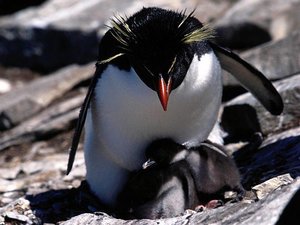 Northern Rockhopper Penguins Eudyptes chrysocome moseley (VU) (Source: Michigan State University)
Northern Rockhopper Penguins Eudyptes chrysocome moseley (VU) (Source: Michigan State University) Gough Island has been described as a strong contender for the title "most important seabird colony in the World", with 54 bird species recorded in total, of which 22 species breed on the island, 20 being seabirds. Four species are threatened. There are three endemic genera .About 48% of the world's population of northern rockhopper penguin Eudyptes chrysocome moseley (VU) breed on Gough. Atlantic petrel Pterodroma incerta (VU) is endemic to Gough and the Tristan group of islands. Gough is also a major breeding site of the great shearwater Puffinus gravis with up to three million pairs breeding on the island. The main southern ocean breeding sites of little shearwater Puffinus assimilis are Tristan da Cunha and Gough Island, with breeding pairs numbering several million. Wandering albatross Diomedea dabbenena (EN) is virtually restricted to Gough, with up to 2,000 breeding pairs. The last survivors of the southern giant petrel Macronectes gigantous (VU) also breed on Gough, with an estimated 100-150 pairs. Gough moorhen Gallinula comeri (VU) is found in fern bush vegetation areas. Estimates of population size vary from 300-500 pairs to 2,000-3,000 pairs. About 200 pairs of Gough finch Rowettia goughensis (VU) have been recorded, although recent estimates suggest that there may be 1,000 pairs.
Subantarctic fur seal Arctocephalus tropicalis (200,000 individuals and increasing), and southern elephant seal Mirounga leonina (about 100 individuals) are the only two native breeding mammals. The former breed at beaches all round the island, while the latter are restricted to the island's sheltered east coast. Two other marine mammals are found within the reserve, namely southern right whale Eubalaena glacialis australis (EN) and dusky dolphin Lagenorhynchus obscurus and the rarely seen Shepherd’s whale Tasmacetus shepherdi has been reported. Reptiles, amphibians, freshwater fish and native terrestrial mammals are absent from the island, although the introduced house mouse Mus musculus is widespread and abundant, posing some threat to birds. 100 free-living species of terrestrial invertebrates have been recorded but have been poorly studied. An additional 24 parasitic invertebrate species have been found on vertebrate hosts on the island. At least eight free-living invertebrate species are endemic to Gough, and an additional 14 species are restricted to Gough and the Tristan group of islands. Only eight species of freshwater (Freshwater biomes) invertebrate are known. Most littoral species found at Gough are widespread on other Southern Ocean islands, and 79 invertebrate species have been recorded. Limpets and bivalves are absent from the littoral and subtidal zones. Sea urchins Arbacia dufresnii are abundant in the marine area, as are whelks Argobuccinun sp., chitons, starfishes, sea anemones, bryzoans, barnacles, slipper limpets, nudibranchs and sponges. Twenty coastal fish species have been recorded and other important marine species include Tristan rock lobster Jasus tristani (from close inshore to 400 m depth around Gough), and octopus Octopus vulgaris. Both are economically exploited by fishermen under close regulation.
On Inaccessible Island the terrestrial fauna, like the flora, has relatively low diversity but a high degree of endemism. There are no land mammals, reptiles, amphibians or freshwater fish. A number of birds and insects are flightless and there are no alien species except for invertebrates, although in the past pigs, goats, sheep and cattle were all introduced. The two marine mammals found on land are the subantarctic fur seals Arctocephalus tropicalis and southern elephant seals Mirounga leonina. Both were abundant until sealing started at the end of the 18 th century and were locally almost exterminated within a hundred years. Elephant seals remain rare, but fur seals have returned, numbering 150 bulls and 500 cows over less than half the coastline in the summer of 1999. Offshore, [[southern right whale]s] Eubalaena australis (EN), which were also decimated during the 19 th century, false killer whales Pseudorca crassidens , humpback whales Megaptera novaeangliae, Tasmanian beaked whales Tasmocetus sheperdi and [[dusky dolphin]s]Lagenorhyncus obscurus have all been sighted. Terrestrial invertebrates have been little studied, although 58 free living species are recorded, 10 being endemic and over 20 introduced. 12 parasitic species have also been found, and two examples of adaptive radiation on the islands, among drosophilid flies and weevils. The marine and littoral environments are even less well known. About 258 species are known, including five seaweeds which may be restricted to the island and 60 recorded species which are endemic to the Tristan group. 25 species of fish are known from the island’s waters with another 17 species probably occurring. These include the one fish endemic to the islands, the klipfish Bovichtus diacanthus. The Tristan rock lobster Jasus tristani is commercially important and octopus is caught with. Marine macro-invertebrate life is scarce but as with Gough, sea urchins and whelks are conspicuous, also the large barnacle Megabalanus isolde.
44 bird species are recorded, of which 16, possibly 20 breed on the island. All but five are seabirds of the subantarctic region: the brown noddy Anous stolidus is a tropical species and there are four native land birds. One species breeds only on Inaccessible Island, the endemic spectacled petrel Procellaria conspicillata (CR). 3-4,000 pairs nest in burrows on the high plateau, one of thirteen burrow-nesting species on the island. Apart from Gough, the island is the only other breeding site of the Tristan or wandering albatross Diomedea dabbenena (EN, 2-3 pairs). Three other breeding species are endemic to the Tristan-Gough islands: great shearwater Puffinus gravis (2 million pairs), Atlantic yellow-nosed mollyhawk Thalassarche chlororhyncos (1,000 pairs) and Atlantic petrel Pterodroma incerta (VU). Two other breeding species are listed as threatened: rockhopper penguin Eudyptes chrysocome moseleyi (VU) and sooty albatross Phoebetria fusca (VU). Only the marauding subantarctic skua Catharacta antarctica feeds on the island, mostly on spectacled petrels. The soft-plumaged petrel Pterodroma mollis and white bellied storm petrel Fregetta gralaria populations are globally important. Of the four land birds the Inaccessible Island rail Atlantisia rogersi (VU), the smallest existing flightless bird, is found only on the island in a population of 8,500. There are three endemic subspecies: Tristan thrush Nesochicla eremita (850 pairs), thick-billed bunting Nesospiza wilkinsi (VU, 2,000 pairs) and Tristan bunting Nesospiza acunhae (VU, 10,000 pairs). The buntings exemplify local adaptive radiation, but may be hybridizing which could eventually produce a new species endemic to the island. All would be vulnerable to mammalian predators.
Cultural Heritage
The Tristan arcihpelago was discovered by Tristão d'Ancunha in 1506, was visited periodically by Dutch sailors and annexed to Britain in 1816. Both Gough and Inaccessible Islands were exploited by sealers in the last decade of the 18th century and early decades of the 19th century. Sealers stayed on Gough Island for considerable periods, subsisting on fish, seabirds, eggs, wild plants and cultivated potatoes (no longer present on Gough). Whaling occurred between 1830 and 1870, and Tristan islanders visited Inaccessible between the 1850s and 1890s to harvest seals and the introduced goats and pigs, but the islands remained uninhabited.
Local Human Population
Gough Island has never been permanently populated and the only inhabitants are the six scientists working at the meteorological station which has functioned since 1956. The only man-made structure on the island is the meteorological station and its associated generators, storerooms, communication facilities and helicopter landing site. Inaccessible Island has been uninhabited except for a two-year farming settlement 1936-38 but has been regularly visited from Tristan for birds, eggs, driftwood, guano and apples. The last pigs, sheep and cattle were removed in the 1950s. Since 1949 its [[coast]al] waters within 50 nm are fished for the Tristan rock lobster Jasus tristani by a single licensee. This, with crayfish fishing, is the island groups' main source of revenue.
Visitors and Visitor Facilities
Access to both islands is prohibited unless written approval has been obtained from the Administrator of Tristan da Cunha, although cruise ships have begun to visit other islands of the group. Landing on Gough is restricted to the coast next to the meteorological station, and on Inaccessible to Blendon Hall Bay, site of the old settlement (and two guided tour landing sites). It is suggested that signs be erected on the islands, stating the conservation objectives, and that detailed information be produced for permitted visitors to the islands. There are no visitor facilities.
Scientific Research and Facilities
Scientists have visited Gough Island periodically from 1811 on. The Gough Island Scientific Survey, the first scientific visit specific to Gough took place in 1955/6, produced the first topographical map of the island. A number of biological and other scientific papers were produced over this period. The scientific base was taken over by the South African Weather Bureau in 1956, and the present weather station was built in 1963. Current research is mainly undertaken by biologists at the Fitzpatrick Institute of African Ornithology of the University of Cape Town. Thirteen short expeditions were completed between 1979 and 1990, with scientific study concentrating on the population dynamics of seabird populations and the island's biota, emphasizing its conservation.
Inaccessible Island has had over 30 mostly brief visits by researchers since 1871. HMS Challenger's day visit in 1873 produced 9 papers, the 17-day Norwegian Scientific Expedition of 1937-38 produced 50 papers, the three-month Denstone College Expedition of 1982-83 produced 17 papers, and three South African Expeditions between 1987 and 1990 under the aegis of the national Antarctic Program produced 23 papers. The hut at Blendon Hall serves as a headquarters. There is an automatic weather station on the island.
Conservation Value
Gough Island is the least disturbed major cool-temperate island ecosystem in the South Atlantic Ocean, and one of the most important sea-bird colonies in the world. The island is scenically beautiful with spectacular sea cliffs round much of the coastline. Two endemic landbirds are found: the Gough moorhen and the Gough finch. Gough is in the Tristan da Cunha Priority One Endemic Bird Area, as defined by BirdLife International. Its undisturbed nature makes it particularly valuable for biological research, which, with weather monitoring, is the only other activity permitted on the island.
Inaccessible Island's values complement those of Gough Island. It is also largely pristine and is one of the few temperate oceanic islands without introduced mammals. It has two birds, eight plants and ten invertebrates found nowhere else, 70 terrestrial plant and animal species are restricted to the islands and 60 marine species are endemic to the island group.
Conservation Management
The Tristan da Cunha Conservation Ordinance of 1976 designated Gough Island and its territorial waters out to 3 nm as a wildlife reserve. This ordinance provided strict legislation to conserve the island and its surrounding marine habitat.
The Tristan da Cunha Fisheries Limits Ordinance 1983, as amended by Ordinances Nos 2 of 1991 and 1992 defines the fisheries (Fisheries and aquaculture) limit as 200 nm around Gough Island and makes provision for fishing within these limits. Commercial fishing without a license is strictly prohibited. The objectives of this comprehensive legislation are to maintain the flora, fauna, geological, scenic and historical features of the island, and to prevent any human-induced change to these. The island is zoned into a logistic zone (6 ha for support of the meteorological station), marine zone, scientific research zones, and the conservation zone (most of the island). Other objectives include the promotion of scientific research, and to create awareness of the value and significance of Gough Island globally. A Gough Island Wildlife Reserve Advisory Committee (GIWRAC) has been established by the Tristan Natural Resources Department to advise the administrator of Tristan da Cunha on matters related to its management, and a representative visits Gough Island once a year. Monitoring of albatrosses is done from the Institute of African Ornithology at the University of Cape Town. At the 290th meeting of the Tristan da Cunha Island Council in 2001 the whole island group was declared a whale sanctuary. The 1993 Management Plan is being updated.
A Management Plan for Inaccessible Island funded by WWF-UK and supported by the government was completed in 2001. It was based on two expeditions, during 1989-90 and 1999-2000. Its aims are to conserve and restore the biota, environment, scenery and historic sites, to exclude alien species and to promote research and the awareness of the island's values. The administration of both islands is by the Island Council of Tristan da Cunha, advised by a group of experts. Strict controls are maintained over access and the introduction of alien species, especially rodents, and continual monitoring is needed. Agriculture is prohibited and any construction requires a permit and can only be done at the Blendon Hall site. Tourism is restricted to the marine zone with guide-controlled small boat landings at two points only. Fishing for rock lobster with octopus as a by-catch is controlled for sustainability and a fisheries patrol vessel helps to enforce the regulations. The fishing is mostly over the submarine plateau west of the island.
Management Constraints
Constraints include unlicensed fishing within the reserve, and illegal use of drift nets. Pollution from the meteorological station is carefully controlled, and there is legislation controlling foreign pollutants, such as vessels passing through the islands' territorial waters. The introduction of alien species is a threat. Goats and sheep have been introduced to the islands in the past, but are no longer present. All supplies to the meteorological station on Gough are carefully checked for alien fauna. In 1990, for example, 10 live exotic snail species were found in an imported cauliflower, along with aphids, caterpillars and mites, all of which were removed from the island. Alien plants originate mainly from seeds found in bird droppings, and are found around the nesting burrows on Inaccessible and in [[coast]al] areas of Gough which are trampled by penguins and seals. The major recent invasion there by procumbent pearlwort required an eradication program during 1999-2000 and the weed will need monitoring and containment for several years. The eradication team suggested that this could be done by staff of the meteorological station. Illegal long-line and driftnet fishing all over the Southern Oceans, including in the islands' territorial limits is killing an increasing number of seabirds.
Staff
Two scientists from the Percy Fitzpatrick Institute of African Ornithology, University of Cape Town, South Africa were appointed Conservation Officers by the Government of Tristan da Cunha in 1990. These officers have many duties, including fisheries (Fisheries and aquaculture) patrol, and are empowered to arrest those disobeying the legislation set out in the Conservation of fauna and flora of Tristan da Cunah Ordinance of 1976.
Budget
No information is available.
IUCN Management Category
- Gough Island Widlife Reserve Ia (Strict Nature Reserve)
- Natural World Heritage Site - Criteria iii, iv
- Extension to site to include Inaccessible Island accepted 2004
Further Reading
- Anon, (1976). Tristan da Cunha Conservation Ordinance. Administrator to Council, Tristan da Cunha Is.
- ------- (1984). The Conservation (Protected Birds) (Amendment) Order. Administrator to Council, Tristan da Cunha Islands.
- Anon, (1983). Tristan da Cunha Fishery Limits Ordinance, and amendments, 1991 and 1992. Governor of St .Helena and its Dependencies.
- Andrew, T.G. et al., (1994). The fishes of the Tristan da Cunha Group and Gough Island, South Atlantic Ocean. Ichthyological Bulletin - JLB Smith Institute of Ichthyology Rhodes University Grahamstown 53. (Unseen).
- Bester, M.N. (1990) Population trends of Subantarctic Fur Seals and Southern Elephant Seals at Gough Island. South African Journal of Antarctic Research 20: 9-12. (Unseen).
- Bourne, W.R.P. (1981) Fur seals return to Gough Island. Oryx 16 46-47. (Unseen)
- Chamberlain, Y.M., Holdgate, M.W. and Wace, N.M. (1985) The littoral ecology of Gough Island, South Atlantic Ocean. Tethys 11: 302-319. (Unseen).
- Collar, N. and Stuart, S. (1985) Threatened birds of Africa and related islands. The ICPB/IUCN Bird Red Data Book. Part 1. International Council for the Preservation of Birds and International Union for the Conservation of Nature and Natura Resources, Cambridge. ISBN: 2880326044
- Collar, N.J, Crosby, M.J., Stattersfield, A.J., (1994) Birds to Watch 2, the World List of Threatened birds. Birdlife International.
- Cooper, J. and Ryan, P.G. (1992) The current conservation status of Gough Island. Paper presented at the SCAR/IUCN Workshop on Protection, Research and Management of Sub-Antarctic Islands. paimpont, France, April 1992.
- Cooper, J. and Ryan, P.G. (1994). Management Plan for the Gough Island Wildlife Reserve. Government of Tristan da Cunha, Edinburgh, Tistan da Cunha. 96 pp.
- Glass,N., Lavarello,I.,Glass, J. & Ryan, P. (2000). Longline fishing at Tristan da Cunha: impacts on seabirds. Atlantic Seabirds 2:49-56.
- Gremmen,N. & Barendse, J. (2000). Eradication of Sagina procumbens (Procumbent Pearlwort) in the Gough Island Wildlife Reserve. Report for the Tristan da Cunha Administration. 24pp.
- Hellyer, P. & Swales, M. (1998). Bibliography of Tristan da Cunha. Anthony Nelson, Oswestry, U.K.
- Heaney, J.B. and Holdgate, M.W. (1957) The Gough Island Scientific Survey. Geographical Journal 123: 20-31 (Unseen).
- Holdgate, M.W. (1965) The biological report of the Royal Society expedition to Tristan da Cunha, 1962, part III - The fauna of the Tristan da Cunha islands. Philosophical Transactions - Royal Society of London Series B Biological Sciences 249: 361-402 (Unseen).
- IUCN (1985). Conservation of Islands in the Southern Ocean: A review of the protected areas of Insulantarctica. International Union for Conservation of Nature and Natural Resources, Switzerland and Cambridge, U.K. Pp 123-129.
- Oldfield, S. (1994) Nomination of Gough Island for inclusion in the World Heritage List. Joint Nature Conservation Committee.
- Proctor, D. & Fleming L. (1999). Biodiversity: the United Kingdom Overseas Territories. Joint National Conservation Committee, Peterborough, U.K.
- Richardson, M.E. (1984) Aspects of the ornithology of the Tristan da Cunha group and Gough Island, 1972-1974. Cormorant 12: 123-201. (Unseen)
- Rogers, R. (1927). The Lonely Island. Project Canterbury. Morehouse Publishing Co., Milwaukee, U.S.A.
- Ryan, P. & Cooper,J. (1991). Rockhopper penguins and other marine life threatened by driftnet fisheries at Tristan da Cunha. Oryx 25:76-79.
- Ryan, P. & Glass, J. (2001). Inaccessible Island Nature Reserve Management Plan. Report for the Government of Tristan da Cunha.
- Tagart, E. (1832) A memoir of the late Captain Peter Heywood, RN. London. (Unseen).
- Wace, N.M. (1961) The vegetation of Gough Island. Ecological Monographs 31: 337-367.(Unseen).
| Disclaimer: This article is taken wholly from, or contains information that was originally published by, the United Nations Environment Programme-World Conservation Monitoring Centre (UNEP-WCMC). Topic editors and authors for the Encyclopedia of Earth may have edited its content or added new information. The use of information from the United Nations Environment Programme-World Conservation Monitoring Centre (UNEP-WCMC) should not be construed as support for or endorsement by that organization for any new information added by EoE personnel, or for any editing of the original content. |
